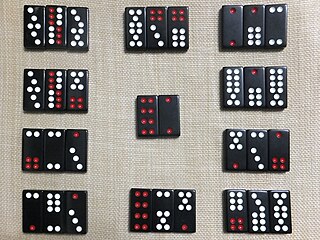
Chinese dominoes are used in several tile-based games, namely, tien gow, pai gow, tiu u and kap tai shap. In Cantonese they are called gwāt pái (骨牌), which literally means "bone tiles"; it is also the name of a northern Chinese game, where the rules are quite different from the southern Chinese version of tien gow.

Dominoes is a family of tile-based games played with gaming pieces. Each domino is a rectangular tile, usually with a line dividing its face into two square ends. Each end is marked with a number of spots or is blank. The backs of the tiles in a set are indistinguishable, either blank or having some common design. The gaming pieces make up a domino set, sometimes called a deck or pack. The traditional European domino set consists of 28 tiles, also known as pieces, bones, rocks, stones, men, cards or just dominoes, featuring all combinations of spot counts between zero and six. A domino set is a generic gaming device, similar to playing cards or dice, in that a variety of games can be played with a set. Another form of entertainment using domino pieces is the practice of domino toppling.
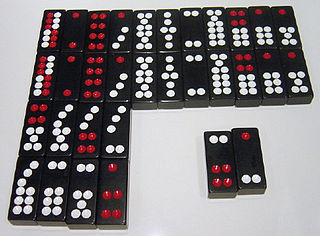
Pai gow is a Chinese gambling game, played with a set of 32 Chinese dominoes. It is played in major casinos in China ; the United States ; Canada ; Australia; and New Zealand.
Pips are small but easily countable items, such as the dots on dominoes and dice, or the symbols on a playing card that denote its suit and value.
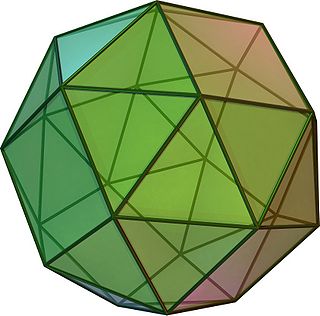
In geometry, the snub cube, or snub cuboctahedron, is an Archimedean solid with 38 faces: 6 squares and 32 equilateral triangles. It has 60 edges and 24 vertices.

Triominoes is a variant of dominoes using triangular tiles published in 1965. A popular version of this game is marketed as Tri-Ominos by the Pressman Toy Corp.
10 (ten) is the even natural number following 9 and preceding 11. Ten is the base of the decimal numeral system, the most common system of denoting numbers in both spoken and written language.

A wallpaper is a mathematical object covering a whole Euclidean plane by repeating a motif indefinitely, in manner that certain isometries keep the drawing unchanged. For each wallpaper there corresponds a group of congruent transformations, with function composition as the group operation. Thus, a wallpaper group is a mathematical classification of a two‑dimensional repetitive pattern, based on the symmetries in the pattern. Such patterns occur frequently in architecture and decorative art, especially in textiles, tessellations, tiles and physical wallpaper.
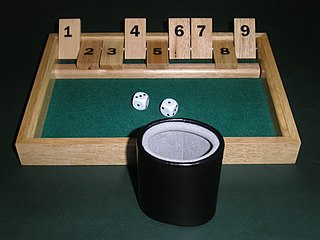
Shut the box is a game of dice for one or more players, commonly played in a group of two to four for stakes. Traditionally, a counting box is used with tiles numbered 1 to 9 where each can be covered with a hinged or sliding mechanism, though the game can be played with only a pair of dice, pen, and paper. Variations exist where the box has 10 or 12 tiles.
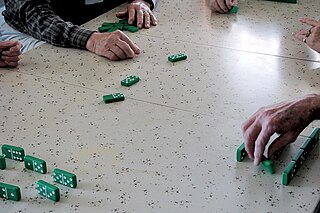
42, also known as Texas 42, is a trick-taking game played with a standard set of double six dominoes. 42 is often referred to as the "state game of Texas". Tournaments are held in many towns, and the State Championship tournament is held annually in Hallettsville, Texas on the first Saturday of March each year. In 2011 it was designated the official State Domino Game of Texas.

Muggins, sometimes also called All Fives, is a domino game played with any of the commonly available sets. Although suitable for up to four players, Muggins is described by John McLeod as "a good, quick two player game".

Mexican Train is a game played with dominoes. The object of the game is for a player to play all the tiles from his or her hand onto one or more chains, or trains, emanating from a central hub or "station". The game's most popular name comes from a special optional train that belongs to all players. However, the game can be played without the Mexican train; such variants are generally called "private trains" or "domino trains". It is related to the game Chicken Foot.
In mathematics, the Schröder number also called a large Schröder number or big Schröder number, describes the number of lattice paths from the southwest corner of an grid to the northeast corner using only single steps north, northeast, or east, that do not rise above the SW–NE diagonal.

A Penrose tiling is an example of an aperiodic tiling. Here, a tiling is a covering of the plane by non-overlapping polygons or other shapes, and a tiling is aperiodic if it does not contain arbitrarily large periodic regions or patches. However, despite their lack of translational symmetry, Penrose tilings may have both reflection symmetry and fivefold rotational symmetry. Penrose tilings are named after mathematician and physicist Roger Penrose, who investigated them in the 1970s.
Serpentiles is the name coined by Kurt N. Van Ness for the hexagonal tiles used in various edge-matching puzzle connection abstract strategy games, such as Psyche-Paths, Kaliko, and Tantrix. For each tile, one to three colors are used to draw paths linking the six sides together in various configurations. Each side is connected to another side by a specific path route and color. Gameplay generally proceeds so that players take turns laying down tiles. During each turn, a tile is laid adjacent to existing tiles so that colored paths are contiguous across tile edges.

The following is a glossary of terms used in dominoes. Besides the terms listed here, there are numerous regional or local slang terms. Terms in this glossary should not be game-specific, i.e. specific to one particular version of dominoes, but apply to a wide range of domino games. For glossaries that relate primarily to one game or family of similar games, see the relevant article.

MacMahon Squares are an edge-matching puzzle first published by Percy MacMahon in 1921, using 24 unique squares with 3-color patterns; each of the four edges is assigned a single color. The complete set of 24 squares are organized next to each other by matching edge colors to create a 4 by 6 grid. Such tessellation puzzles have multiple variants, which are determined by restrictions on how to arrange the 24 squares. This game has also been commercialized in numerous physical forms, by various companies.
Le Trioker is an corner-matching puzzle game played using 25 equilateral triangle-shaped tiles. Each corner is marked with zero, one, two, or three dots and newly placed pieces must match the values on pieces already placed on the game board, similar to the gameplay of the earlier Triominoes.



























